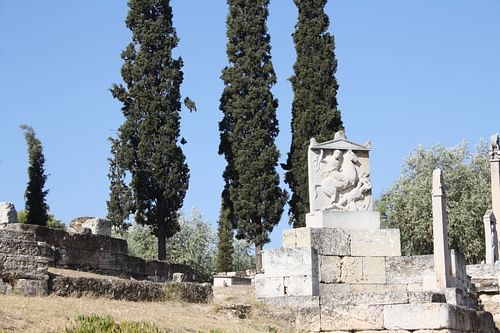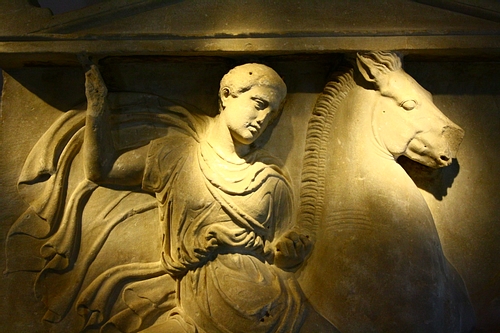The Dexileos Stele assesses the way that Athenian political thought penetrated all levels of society, showing the conflict that the aristocratic classes were faced with in trying to find their place within the Athenian Democracy. As a visual document it presents an image that would have been seen and understood to those who passed it; despite being a cavalryman, a typically elite element of the military, Dexileos was still firmly a part of the Athenian demos. The stele dates to a turbulent time in Athens' history. Having lost the Peloponnesian War, Athens was ruled by 30 Tyrants, and when Democracy was restored, the Tyrants were then harshly punished, and Athens found herself at war with Corinth (c. 394 BCE). The Dexileos Stele perfectly encapsulates the struggles and changing ideologies that were present in Athens at the time, and as a monument to the young man's death, it shows him as his family wished for him to ever be remembered.
Basic Details
The Dexileos stele is 1.86 m high and was found in situ in the Dipylon Cemetery in 1863 CE. It was moved during WWII, and currently is in the Kerameikos Museum in Athens. A replica is in its original location. The monument is made of Pentelic Marble, a not inexpensive variety.
There are varying costs given for classical Athenian burials, ranging from 300 drachmae – 2 talents. Below are some example references from Greek primary sources:
300 dr.
She demurred to committing herself to his care after her death, but as she had confidence in Antiphanes, who was no connection of hers, she gave him three minae of silver for her burial, ignoring this man, who was her own son. Obviously, of course, she was convinced that he would not perform the last duties even on the ground of his relationship. (Lysias 31.21)
1000 dr.
I also borrowed another thousand drachmae from Lysistratus of Thoricus for my father's funeral, and have personally paid the debt. (Demosthenes 40.52)
Moreover, in case my own mother should die, no more than ten minas would be required for the building of her tomb. (Plato, Letters, 13.361e)
2500 or 3000 dr.
Having stated that the tomb cost 50 minae [5000 drachmae], he undertook to pay half of this himself, and charge the other half to the children's estate: but this latter half covered the actual cost. (Lysias 32.21)
2 talents
... her to whom this god-detested fellow built the monument near that of his mistress at a cost of more than two talents. And he did not see that a structure, being of that sort, would be a monument, not of her tomb, but of the wrong which because of him she had done to her husband. (Demosthenese 45.79)
We are able to accurately date not only the monument itself, but also the age at which Dexileos died, because this monument is a rare example of when the date of birth of the deceased is given as well as the date of death. Dexileos was born in Teisander's Archonship (414 BCE) and died in Euboulides' (394 BCE), making him around 20 years old when he died. The whole of the epigram reads:
DEXILEOS, SON OF LYSANIOS OF THORIKOS
BORN IN THE YEAR OF TEISANDROS
DIED IN THE YEAR OF EUBOULIDES IN CORINTH
ONE OF THE FIVE CAVALRYMEN
However, what is even more intriguing is the inscription “one of five cavalrymen”, the only example of such a phrase in all extant classical Attic grave stelai. The fact that it is unique makes interpreting this line particularly challenging; the most likely meaning of the line can be found in Xen. Hipparchus 8.23-5:
If, moreover, he can secretly leave behind him four or five of the best horses and men in each division, they will be at a great advantage in falling on the enemy as he is turning to renew the charge.
We can even postulate the historical background in which Dexileos' actually died; the beginning of the 2nd Campaign in the Corinthian War. In fact, thanks to Xenophon and Diodorus Siculus we can be even more specific: It is likely that Dexileos died either at the Battle of the Nemea River (being close to Corinth) or in a skirmish before or after the battle proper (Xen. Hell. 4.2.9-23 & 4.3.1; Dio.Sic. 14.83).
The Figures
At left:
- Dexileos, aged 20, his youthfulness displayed by his beardlessness and by his clothing, the chiton, chlamys, and petasos (which despite being missing was almost certainly present as a metal attachment), which would later become the standard garb of the Athenian ephebe on tour.
- His footwear is missing but would probably have been similar to those seen in comparable stele; krepides, the kind of boot described by Xen. De Re Equestr. 12. I0: "But the rider's shins and feet will of course be outside the thigh-pieces. These too can be guarded if boots made of shoe-leather are worn: there will thus be armour for the shins and covering for the feet at the same time."
- The weapons, reins, and petasos are missing, leaving behind their stains and holes. Any polychromy is also missing, but might have helped to provide attributable features. Being a cavalryman, he is mounted on a stallion, which is shrunk so as to fit the scene. The horse rears up.
At right:
- A fallen Hellenic foe (presumably a Corinthian given the context of the epigram), still in his youth, raises his right arm to shield himself, unable to wield the shield that he bears. He is naked in contrast to Dexileos' 'uniform' and is trapped underneath Dexileos' stallion.
Dexileos' right arm is raised, his spear bears down on his foe (there being a bored hole on the enemy's neck; the nature of the position of the horse would make it physically impossible for him to actually be speared by the rider). The lines between the figures are primarily linear and parallel, a rigidity which is also born out in the unemotional glance of Dexileos. Stylistically this kind of scene (horseman rearing over fallen foe) can be traced back to scenes on the Parthenon Amazonomachy; despite this it is still referred to as the 'Dexileos Motif'.
Architectural Details
The scene is framed by a pediment with acroteria, which cannot be to protect the relief, since elements extrude past it. Neither can it be to depict an inside scene. We can,, therefore, draw out its religious connotations with regards to the naiskos, the sanctuary, and the hero cult (pedimental architecture never occurred in Greek domestic settings).
However, despite being brilliantly preserved, there are elements of this monument which haven't survived, such as metal arms and details, as well as the polychromy, which would almost certainly have painted a scene on the pediment.
Context
Whilst this monument is ostentatiously aristocratic, depicting the young Dexileos as a cavalryman, it does so without being intrinsically anti-democratic. The epigram is rare in that it gives the year of his birth, hence making it clear that Dexileos was too young to have been a part of the anti-democratic tyrannies at the end of the 5th century BCE. As well as doing this, it makes clear that Dexileos would still have been an ephebe, in the process of becoming a democratic citizen. Further, saying that Dexileos' father Lysanios came from the trittys Thorikos helped to place Dexileos within another democratic context. The inclusion of a vase at the cemetery plot that depicted the Tyrannicides is telling, too, being an overtly democratic image.
The monument, however, is one of three which commemorate Dexileos in one way or another. The first monument is the Polyandron, which was set up in honour of all of Athens' soldiers who died in a particular year (in this case 395/4 BCE). As part of this ritual honouring of those who died for the city, their ashes were burned and placed together in the Demosion Sema; in death all were equal - ashes of rich cavalrymen were mixed with the less affluent foot soldiers. This mixing of individuals to form a complete democracy can be seen in the imagery of the Polyandron for 395/4 BCE, where a cavalryman and hoplite are united in their killing of a foe. The second monument is that which was set up for the cavalrymen that fell; a total of eleven are listed. Whilst this monument separates the aristocratic order from the democracy as a whole, it shows that those who survived wanted their sacrifice to the democracy to be remembered. This is a key element: the cavalry wishing to be seen as part of the democracy, rather than separate from it. In particular this would be due to the tryannies in Athens at the end of the 5th century BCE, which so many of the cavalry classes were involved in, after which those who had survived exile or worse after democracy was restored, wished to distance themselves from what had gone on before them. Bearing this in mind, it is important to note that Dexileos' year of birth was given, showing him to be ten during the reign of the 30 Tyrants, too young to have taken part in any anti-democratic actions.
What else this date reveals is that Dexileos was also an ephebe at the time of his death. Becoming an ephebe was the Athenian 'rite of passage', which resulted in a young Athenian becoming a full, adult Athenian citizen. It involved three years' military service, the last two on patrol. This epigraphic detail is supported by the clothes that Dexileos wears, the chlamys cloak, bellowing out behind him:
Their service on patrol goes on for two years; the uniform is a chlamys.
(Aristotle, Athenian Constituition 42)
Bearing this in mind we can postulate that Dexileos, where there is a hole for a metal attachment on his head, would have worn the petasos, the wide-brimmed hat worn by travellers and what would iconographically become part of the ephebic uniform from the middle of the 4th century BCE. In support of this is NMA, 3708, a base with two carved reliefs almost identical iconographically to Dexileos, where the rearing cavalryman can be clearly seen wearing a petasos. If this supposition as to Dexileos' headwear is correct, it further helps to identify him as an ephebe, a youth within and part of Athens' democratic system, helping to place his death within the context of a democratic sacrifice.
However, we cannot ignore the written evidence. There are two clear-cut ideologies behind dying in battle that were put forward in classical Athens. During the Peloponnesian War, Pericles' funeral speech places the death of Athenian citizens within the broader context of Athenian democracy, rather than as a personal sacrifice in order to gain honour, as might be seen by Lysias' later Funeral Oration 79-80, which praises instead the glory and heroism that the individual gains from such an action:
Of their nature it comes that they are mourned as mortal, of their valour that they are lauded as immortal. Thus you see them given a public funeral, and contests of strength and knowledge and wealth held at their tomb; because we think that those who have fallen in war are worthy of receiving the same honours as the immortals.
Being closer in date to Lysias, it is surprising therefore that this stele isn't more individualistic, considering changing tendencies that were occurring in funeral stelai at the turn of the century when familial scenes increased, but also considering that this is the third monument that commemorates Dexileos, and was set up by his family. He is, admittedly, more of an individual here than on the state and cavalry monuments that were set up, but what this stele wishes to show is how he conforms to an idealised standard of citizenry (and in the process show him victorious in battle, a praise-worthy deed - a halfway house between the ideologies exposed by Pericles and Lysias). It is telling that despite not being a full citizen of the Athenian democracy, these attributes can still be given to him, suggesting the importance that was given at this time for aristocratic inclusion within Athens' democracy.









